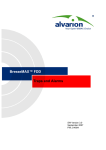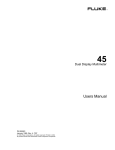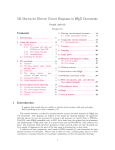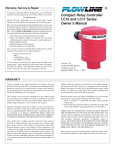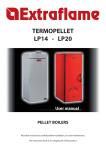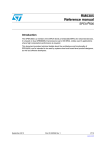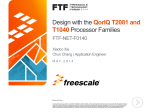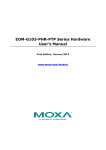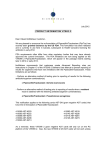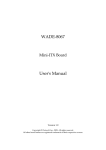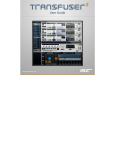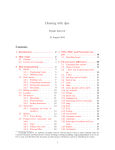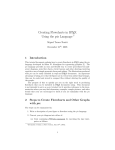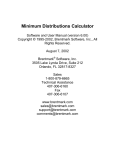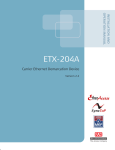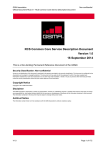Download User Manual - DSS Networks
Transcript
DSS NETWORKS Metro-Switch Gigabit Backplane Switch Fabric Board and Firmware Users Manual (Includes models 8260, 8261 and 8261-RIO) Firmware Version 1.14g, Document p/n 131902 May 2007 Gigabit Ethernet Metro-Switch Board and Firmware Users Manual 1. INTRODUCTION..................................................................................................... 4 1.1 CAPABILITIES OVERVIEW .................................................................................. 4 1.2 USE AND TARGET APPLICATIONS.................................................................... 5 1.3 KIT CONTENTS .................................................................................................... 5 1.4 REFERENCES...................................................................................................... 5 1.5 COMPATIBILITY ................................................................................................... 6 2. MODEL / PART NUMBERS .................................................................................... 6 3. FEATURES ............................................................................................................. 8 4. SYSTEM REQUIREMENTS.................................................................................... 9 5. BOARD AND CONNECTOR INFORMATION ....................................................... 10 5.1 COMPONENT DIAGRAM ................................................................................... 10 5.2 BOARD PHOTOS ............................................................................................... 10 5.2 BOARD PHOTOS ............................................................................................... 11 5.3 BOARD LED INDICATORS................................................................................. 13 5.4 CPCI CONNECTOR PIN/SIGNAL DEFINITIONS ............................................... 14 6. POWER CONSUMPTION SPECIFICATIONS ...................................................... 20 7. HARDWARE INSTALLATION ............................................................................... 20 7.1 SERIAL PORT CABLE DIAGRAM ...................................................................... 22 8. COPPER AND FIBER CABLING .......................................................................... 23 8.1. FIBER CABLE SPECIFICATIONS ..................................................................... 23 8.2 COPPER RJ-45 CONNECTOR AND CAT5 CABLE ........................................... 23 9. UNIT OPERATION................................................................................................ 25 9.1 SERIAL PORT CLI COMMAND LINE INTERFACE ............................................ 25 9.1.1 HELP COMMAND ............................................................................................ 27 9.1.2 VLAN TABLE SET COMMAND........................................................................ 27 9.1.3 VLAN TABLE SHOW COMMAND.................................................................... 28 9.1.4 VLAN TABLE REGISTER COMMAND ............................................................ 29 9.1.5 CFG SAVE COMMAND ................................................................................... 29 9.1.6 CFG CLEAR COMMAND ................................................................................. 29 9.1.7 SWITCH RESET COMMAND .......................................................................... 29 9.1.8 SETTING PACKET AGING .............................................................................. 29 9.1.9 SETTING DEFAULT VLAN .............................................................................. 30 9.1.10 SETTING UNTAGGED VLAN ID’s ................................................................. 30 9.1.11 ‘EEREG SET’ COMMAND ............................................................................. 32 9.1.12 ‘EEREG CLR’ COMMAND ............................................................................. 33 9.1.13 ‘EEREG SHOW’ COMMAND ......................................................................... 33 9.1.14 LINK COMMAND ........................................................................................... 34 9.1.15 LINK REGS COMMAND ................................................................................ 35 9.1.16 GMAC STATS SHOW COMMAND ................................................................ 37 9.1.17 GMAC STATS CLEAR COMMAND ............................................................... 38 9.1.18 GMAC REGS SHOW COMMAND ................................................................. 38 9.1.19 GENERAL STATS COMMAND...................................................................... 38 9.1.20 GPIC REGS SHOW COMMAND ................................................................... 39 9.1.21 SGMII REGS SHOW COMMAND .................................................................. 40 9.1.22 SGMII STATUS SHOW COMMAND .............................................................. 40 DSS NETWORKS, INC. Version: 1.14g Page: 2 Gigabit Ethernet Metro-Switch Board and Firmware Users Manual 9.1.23 EEPROM CONTENTS SHOW COMMAND ................................................... 41 9.1.24 EPROM INIT COMMAND.............................................................................. 41 9.1.25 EEPROM TEST READ COMMAND ............................................................... 41 9.1.26 MMU REGS SHOW COMMAND.................................................................... 41 9.1.27 CMIC REGS SHOW COMMAND ................................................................... 42 9.1.28 ARL REGS SHOW COMMAND ..................................................................... 43 9.1.29 STG SHOW COMMAND ................................................................................ 43 9.1.30 ‘GIMASK SET’ COMMAND ............................................................................ 44 9.1.31 ‘GIRULE SET’ COMMAND............................................................................. 46 9.1.32 ‘GIMASK SHOW’ COMMAND........................................................................ 47 9.1.33 ‘GIRULE SHOW’ COMMAND ........................................................................ 48 9.1.34 ‘GIMASK SHOW REGISTER’ COMMAND..................................................... 49 9.1.35 ‘GIRULE SHOW REGISTER’ COMMAND ..................................................... 49 9.1.36 ‘GFFP-CTR’ SHOW COMMAND.................................................................... 50 9.1.37 ‘GFFP-CTR’ CLEAR COMMAND................................................................... 51 9.1.38 ‘GFFP-PKT’ CLEAR COMMAND ................................................................... 51 9.1.39 ‘GFFP-PKT’ SHOW COMMAND .................................................................... 51 9.1.40 MIRROR CONTROL SET COMMAND........................................................... 52 9.1.41 MIRROR CONTROL SHOW COMMAND ...................................................... 53 9.1.42 MIRROR CONTROL REGS COMMAND ....................................................... 54 9.1.43 MIRROR CONTROL CLEAR COMMAND...................................................... 54 9.1.44 EGRESS MASK (BLOCK MASK) SET COMMAND ....................................... 54 9.1.45 EGRESS MASK (BLOCK MASK) SHOW COMMAND................................... 55 9.1.44 EGRESS MASK (BLOCK MASK) REGS COMMAND.................................... 55 9.1.45 EGRESS MASK (BLOCK MASK) CLEAR COMMAND .................................. 55 9.2 TEST METHODS ............................................................................................... 56 10. ON BOARD FIRMWARE..................................................................................... 57 10.1 INTRODUCTION............................................................................................... 57 10.2 BLOCK DIAGRAM ............................................................................................ 58 10.3 FIRMWARE DEVELOPMENT ENVIRONMENT ............................................... 58 10.3 FIRMWARE DEVELOPMENT ENVIRONMENT ............................................... 59 11. SPECIFICATIONS .............................................................................................. 60 11.1 ENVIRONMENTAL SPECIFICATIONS............................................................. 62 11.2 MECHANICAL SPECIFICATIONS .................................................................... 64 11.3 INDUSTRY STANDARDS COMPLIANCE ........................................................ 64 11.4 SNMP SUPPORT MIB COUNTERS ................................................................. 64 11.5 PERFORMANCE AND CAPABILITIES ............................................................. 65 11.6 MANAGEMENT FEATURES............................................................................. 66 11.7 HARDWARE SPECIFICATIONS....................................................................... 67 12. WARRANTEE AND SUPPORT INFO ................................................................. 68 DSS NETWORKS, INC. Version: 1.14g Page: 3 Gigabit Ethernet Metro-Switch Board and Firmware Users Manual 1. INTRODUCTION The Metro-Switch family of embedded Gigabit Ethernet switches are a highperformance, flexible and cost-effective solution for adding scalable Gigabit Ethernet switching capabilities for use in standalone or rackmount embedded systems applications. The Models 8260 and 8261 support 12-ports of 10/100/1000 Base T over copper or 10ports copper and 2 ports of 1000 Base X over optical fiber. The Model 8260 is a L2+ or L3 switch utilizing lower cost switch L2+ and L3 switch devices from Broadcom. The Model 8261 uses higher end multi-layer (L2 – L7) switch devices also in the Broadcom StrataXGS family. Both models provide an extensive list of features including an onboard management processor with extensible value-added firmware making it ideal for use in many embedded systems applications. 1.1 CAPABILITIES OVERVIEW The Metro-Switch models feature 12 ports of 10/100/1000 Base T Gigabit Ethernet over Copper with two 1000 Base SX/LX fiber uplinks. It is PICMG 2.16 6U fabric card compliant and compatible with both standard CompactPCI® and PICMG 2.16 backplanes. All 12-ports may be routed to slots on the Compact PCI backplane or externally via rear I/O. A system management interface is also supported via the PICMG 2.9 IPMI interface. It optionally supports two 1000 base SX/LX gigabit fiber ports with standard SFF LC connectors via the front panel. It has an onboard RISC/DSP processor for local management and can be operated as a standalone or fully managed switch. LEDS are provided for each port showing link status, transmit and receive and link quality. All LEDS are multifunction and can be used for additional functions including cable testing and energy detection. It is also PICMG 2.1 R2.0 hot-swap compliant providing support for the hardware connection layer. The Metro-Switch models use the latest advanced high-performance, full-featured and highly integrated 12-port Broadcom StrataSwitch BCM56XX L2+, L3 or multilayer switches and BCM5464SR quad-port transceivers and are fully 802.3 compliant. They provide a fully non-blocking 24Gb/32 million frames per second aggregate switching fabric. The switching function supports an extended list of features including layer 3 switching, link aggregation, 802.1Q VLANs, 802.1D spanning tree and priority-based 802.1D/802.1p CoS/traffic class expediting and dynamic multicast filtering. The switch can be configured in a fully redundant, non-blocking network that prevents single points of failure from congesting network traffic. It provides advanced cell and packet based “head of line” blocking prevention techniques, has 1MB of onboard memory for packet buffering, and supports a 10-gig uplink interface. Extended ethernet frame sizes to 9KB are supported. Additional advanced features including rules-based layer 2-7 packet classification/filtering on 128 multiple data flows, port trunking and port mirroring are provided for advanced networking and flow techniques. Network management support DSS NETWORKS, INC. Version: 1.14g Page: 4 Gigabit Ethernet Metro-Switch Board and Firmware Users Manual includes fully configurable routing tables and RMON, SNMP, Ethernet and extended MIB(s). A 32-bit, 66 MHZ PCI interface is also provided to support system management via the PCI bus and the switch can additionally route packets to/from the PCI interface as a “virtual port” function. This would allow for example, SNMP or other management packets to be routed to an external processing component in a distributed network management scheme. 1.2 USE AND TARGET APPLICATIONS The Metro-Switch 12-port switches are equipped ready-to-use out of the box with no additional software or drivers required. In this most basic operational mode it is used as a standalone switch installed in a rackmount chassis. An additional mode allows it to be controlled in a simple managed mode using a serial port Command Line Interface (CLI). The CLI allows more sophisticated configuration and control management while still operating as a standalone switch. The most functional mode allows it to be controlled in a fully managed switch mode from an external processor communicating with the Metro-Switch over the PCI bus via the JN1 CPCI connector. The Metro-Switch models are targeted for OEMs and Systems Integrators for use in Data and Telecommunications products including switches, multiplexers, edge routers, media gateways and video broadcasting equipment. It is well suited for support of embedded broadband applications including Internet voice, digital video, IP security, network monitoring, military applications and test equipment. 1.3 KIT CONTENTS Metro-Switch 12-port board with front panel mounting and ejector handles Serial-port RJ11 male to DB9 female cable Telnet adapter module (ordered under a separate P/N or customer supplied) User Manual OEM Developer Kit CD 1.4 REFERENCES Please also see the following documents on our website at www.dssnetworks.com and also included in the OEM developers kit CD: Datasheets – please see product datasheets and other updated product information on OEM developer CD and on website. Release Notes -- where updated information is provided on new features, compatibility, performance benchmarks, platform information and corrected problems. DSS NETWORKS, INC. Version: 1.14g Page: 5 Gigabit Ethernet Metro-Switch Board and Firmware Users Manual 1.5 COMPATIBILITY The Metro-Switch is fully compliant with the following standards: IEEE 802.3-2002 (all sections applicable to 1000 Base T, 1000 Base SX, 1000 Base LX) IEEE 802.1D and IEEE 802.1Q as applicable for VLAN and priority queuing support PCI 2.2 bus compliant, 32-bit 33/66 MHZ PICMG 2.0 R3.0 Compact PCI compliant (6U form factor) PICMG specifications: 2.16 R1.0 Packet Switching Backplane (PSB) complaint fabric board PICMG 2.9 IPMI support PICMG 2.1 R2.0 hot-swap (basic hot-swap hardware connection layer) Telnet remote terminal access standard 2. MODEL / PART NUMBERS This user manual covers all models of our Metro-Switch product line including: Model 8260 Part Number Model Description Copper ports Fiber ports Switch type 182602 8260 12-port Compact PCI PICMG 2.16 compliant switch 12 (10/100/1000 Base T) 2 (1000 Base SX 850nm multimode LC fiber) L2+ and L3 Part Number Model Description Copper ports Fiber ports Switch type 182606 8260 12-port Compact PCI PICMG 2.16 compliant switch 12 (10/100/1000 Base T) 2 (1000 Base LX 1310nm singlemode LC fiber) L2+ and L3 DSS NETWORKS, INC. Version: 1.14g Page: 6 Gigabit Ethernet Metro-Switch Part Number Model Description # Copper ports # Fiber ports Switch type Board and Firmware Users Manual 182604 8260 12-port Compact PCI PICMG 2.16 compliant switch 12 (10/100/1000 Base T) 0 (without fiber uplinks) L2+ and L3 Model 8261 Part Number Model Description Copper ports Fiber ports Switch type 182612 8261 12-port Compact PCI PICMG 2.16 compliant switch 12 (10/100/1000 Base T) 2 (1000 Base SX 850nm multimode LC fiber) Multilayer (L2 – L7) Part Number Model Description Copper ports Fiber ports Switch type 182616 8261 12-port Compact PCI PICMG 2.16 compliant switch 12 (10/100/1000 Base T) 2 (1000 Base LX 1310nm singlemode LC fiber) Multilayer (L2 – L7) DSS NETWORKS, INC. Version: 1.14g Page: 7 Gigabit Ethernet Metro-Switch Part Number Model Description # Copper ports # Fiber ports Switch type Board and Firmware Users Manual 182614 8261 12-port Compact PCI PICMG 2.16 compliant switch 12 (10/100/1000 Base T) 0 (without fiber uplinks) Multilayer (L2 – L7) Note: Please note that copper ports 10 and 11 are not active when fiber ports are used. 3. FEATURES The Metro-Switch adapter offers the following key features: • • • • • • • • • • • • • • • • • • • • • • 12-port full-duplex Gigabit Ethernet interfaces routed to 2.16 backplane or rear I/O Optional support for 2 multimode or singlemode fiber links (850nm MM or 1310nm SM LC) Sustained aggregate throughput of 24 Gbps (3 GB) Frame processing rate of up to 32 million frames per Onboard RISC management processor and EEPROM configuration 4 multi-function LEDS per port (TX, RX, LINK, Signal Quality) 32-bit, 66 MHZ PCI interface Onboard RS232 (RJ-11 jack) for serial port console support Remote network access via Telnet Basic hot-swap support for hardware connection layer Installs in CompactPCI PICMG 2.16 compliant system chassis Optionally installs in standard Compact PCI PICMG 2.0 R3.0 chassis Available with 12-port rear I/O transition module Ideal solution for CompactPCI rackmount embedded systems Utilizes single 5V power from JN1/JP1 PCI connector Provides power regulators onboard for power distribution (3.3V, 2.5V, 1.25V) Complies with all PCI revision 2.2 mechanical and electrical requirements Fully IEEE 802.3z, IEEE 802.3ab, 802.3u and IEEE 1386 compliant Compatible with all 10/100/1000BaseT hubs, switches and routers Operates as standalone Layer 2 switch or fully managed L3/multiplayer switch Jumbo frame support for up to 9K 802.3x full duplex flow control DSS NETWORKS, INC. Version: 1.14g Page: 8 Gigabit Ethernet Metro-Switch Board and Firmware Users Manual 4. SYSTEM REQUIREMENTS Compact PCI PSB Platform: Compact PCI compliant (PICMG 2.16, PICMG 2.0 R3.0) Size 6U chassis and slots, power supply and fan(s) Packet Switching Backplane Compliant to PICMG 2.16 R1.0 At least one fabric slot required Metro-Switch installs into fabric slot in PICMG 2.16 PSB backplane Note: The Metro-Switch may also be installed into peripheral slot on standard Compact PCI chassis with H.110 compatible backplane for connections via rear I/O only, however all pins on CPCI connectors “J3” and “J5” must be passive and comply to PICMG 2.16 signal definitions and routed to rear I/O. DSS NETWORKS, INC. Version: 1.14g Page: 9 Gigabit Ethernet Metro-Switch Board and Firmware Users Manual 5. BOARD AND CONNECTOR INFORMATION 5.1 COMPONENT DIAGRAM DSS NETWORKS, INC. Version: 1.14g Page: 10 Gigabit Ethernet Metro-Switch Board and Firmware Users Manual 5.2 BOARD PHOTOS Model 8261 - P/N 182612 (shown without heat sinks) DSS NETWORKS, INC. Version: 1.14g Page: 11 Gigabit Ethernet Metro-Switch Board and Firmware Users Manual Model 8261-RIO - P/N 182618 DSS NETWORKS, INC. Version: 1.14g Page: 12 Gigabit Ethernet Metro-Switch Board and Firmware Users Manual 5.3 BOARD LED INDICATORS There are 12 LED arrays marked “P0” thru “P11” on the front panel. Each port array has 4 green LEDS and their meaning is described in the following table: Port LED Arrays (P0 – P11) Function Table (from left to right) Gigabit Switch Model 8260/8261 LED # 1 Green Link LED # 2 LED #3 Green Yellow TX RX LED #4 Yellow Quality* Note: The Quality LED is only available for ports in 1000-Base-T copper mode. There is also a single LED Array containing a row of 3 LEDS (2 Yellow, 1 Green) described in the following table: Processor LED (LED1) Function Table (left to right) Gigabit Switch Model 8260/8261 LED # 1 YEL Warn LED # 2 LED #3 YEL Green LinkSt RUN Note: After power on and during normal operation, the green “RUN” LED should always blink at a slow steady heartbeat pace of about once per every 2 seconds. DSS NETWORKS, INC. Version: 1.14g Page: 13 Gigabit Ethernet Metro-Switch Board and Firmware Users Manual 5.4 CPCI CONNECTOR PIN/SIGNAL DEFINITIONS The MetroSwitch models use the J1, J3 and J5 Compact PCI connectors as shown in the following diagrams. Connectors J2 and J4 are not used. Board Connectors pin diagram J1 CPCI Connector J1 Signal Name CPCI Connector J1 Signal Name A1 A2 A3 A4 A5 A6 A7 A8 A9 A10 A11 A12 A13 A14 A15 A16 A17 A18 A19 A20 A21 A22 A23 A24 A25 EARLY_5V P_TCK P_INTA_N P_IPMB_PWR NC P_REQ_N P_AD30 P_AD26 P_CBEN3 P_AD21 P_AD18 NC NC NC EARLY_3V P_DEVSEL_N EARLY_3V P_SERR_N EARLY_3V P_AD12 EARLY_3V P_AD7 EARLY_3V P_AD1 EARLY_5V B1 B2 B3 B4 B5 B6 B7 B8 B9 B10 B11 B12 B13 B14 B15 B16 B17 B18 B19 B20 B21 B22 B23 B24 B25 -12V EARLY_5V INTB# P_HEALTHY_N RESERVED GND/PCI_PRSNT# P_AD29 GND P_IDSEL GND P_AD17 NC NC NC P_FRAME_N P_PCIXCAP P_IPMB_SCL GND P_AD15 GND P_AD9 GND P_AD15 EARLY_5V REQ64# C1 C2 C3 C4 C5 C6 C7 C8 C9 C10 C11 C12 C13 C14 C15 C16 P_TRST_N P_TMS INTC# EARLY_VIO P_RST_N EARLY_3V P_AD28 EARLY_VIO P_AD23 EARLY_3V P_AD16 NC NC NC P_IRDY_N EARLY_VIO D1 D2 D3 D4 D5 D6 D7 D8 D9 D10 D11 D12 D13 D14 D15 D16 +12V P_TDO EARLY_5V INTP GND P_PCICLK GND P_AD25 GND P_AD20 GND NC NC NC P_BDSEL_N P_STOP_N DSS NETWORKS, INC. Version: 1.14g Page: 14 Gigabit Ethernet Metro-Switch Board and Firmware Users Manual C17 C18 C19 C20 C21 C22 C23 C24 C25 P_IPMB_SDA EARLY_3V P_AD14 EARLY_VIO P_AD8 EARLY_3V P_AD3 EARLY_VIO P_ENUM_N D17 D18 D19 D20 D21 D22 D23 D24 D25 GND P_PAR GND P_AD11 P_M66EN P_AD6 EARLY_5V P_AD0 EARLY_3V E1 E2 E3 E4 E5 E6 E7 E8 E9 E10 E11 E12 E13 E14 E15 E16 E17 E18 E19 E20 E21 E22 E23 E24 E25 EARLY_5V P_TDI INTD# INTS P_GNT_N P_AD31 P_AD27 P_AD24 P_AD22 P_AD19 P_CBEN2 NC NC NC P_TRDY_N LOCK# P_PERR_N P_CBEN1 P_AD13 P_AD10 P_CBEN0 P_AD5 P_AD2 ACK64# EARLY_5V F1 F2 F3 F4 F5 F6 F7 F8 F9 F10 F11 F12 F13 F14 F15 F16 F17 F18 F19 F20 F21 F22 F23 F24 F25 GND GND GND GND GND GND GND GND GND GND GND NC NC NC GND GND GND GND GND GND GND GND GND GND GND DSS NETWORKS, INC. Version: 1.14g Page: 15 Gigabit Ethernet Metro-Switch Board and Firmware Users Manual Board Connectors pin diagram J3 CPCI Connector J3 Signal Name CPCI Connector J3 Signal Name A1 A2 A3 A4 A5 A6 A7 A8 A9 A10 A11 A12 A13 A14 A15 A16 A17 A18 A19 MDIB_P-1 MDIA_P-1 MDIB_P-2 MDIA_P-2 MDIB_P-3 MDIA_P-3 MDIB_P-4 MDIA_P-4 MDIB_P-5 MDIA_P-5 MDIB_P-6 MDIA_P-6 MDIB_P-7 MDIA_P-7 MDIB_P-8 MDIA_P-8 LP1-DB_P LP1-DA_P SGA4 B1 B2 B3 B4 B5 B6 B7 B8 B9 B10 B11 B12 B13 B14 B15 B16 B17 B18 B19 MDIB_N-1 MDIA_N-1 MDIB_N-2 MDIA_N-2 MDIB_N-3 MDIA_N-3 MDIB_N-4 MDIA_N-4 MDIB_N-5 MDIA_N-5 MDIB_N-6 MDIA_N-6 MDIB_N-7 MDIA_N-7 MDIB_N-8 MDIA_N-8 LP1-DB_N LP1-DA_N SGA3 C1 C2 C3 C4 C5 C6 C7 C8 C9 C10 C11 C12 C13 C14 C15 C16 C17 C18 C19 GND GND GND GND GND GND GND GND GND GND GND GND GND GND GND GND GND GND SGA2 D1 D2 D3 D4 D5 D6 D7 D8 D9 D10 D11 D12 D13 D14 D15 D16 D17 D18 D19 MDID_P-1 MDIC_P-1 MDID_P-2 MDIC_P-2 MDID_P-3 MDIC_P-3 MDID_P-4 MDIC_P-4 MDID_P-5 MDIC_P-5 MDID_P-6 MDIC_P-6 MDID_P-7 MDIC_P-7 MDID_P-8 MDIC_P-8 LP1-DD_P LP1-DC_P SGA1 E1 E2 E3 E4 E5 E6 E7 E8 MDID_N-1 MDIC_N-1 MDID_N-2 MDIC_N-2 MDID_N-3 MDIC_N-3 MDID_N-4 MDIC_N-4 F1 F2 F3 F4 F5 F6 F7 F8 GND GND GND GND GND GND GND GND DSS NETWORKS, INC. Version: 1.14g Page: 16 Gigabit Ethernet Metro-Switch E9 E10 E11 E12 E13 E14 E15 E16 E17 E18 E19 MDID_N-5 MDIC_N-5 MDID_N-6 MDIC_N-6 MDID_N-7 MDIC_N-7 MDID_N-8 MDIC_N-8 LP1-DD_N LP1-DC_N SGA0 DSS NETWORKS, INC. Board and Firmware Users Manual F9 F10 F11 F12 F13 F14 F15 F16 F17 F18 F19 GND GND GND GND GND GND GND GND GND GND GND Version: 1.14g Page: 17 Gigabit Ethernet Metro-Switch Board and Firmware Users Manual Board Connectors pin diagram J5 CPCI Connector J5 Signal Name CPCI Connector J5 Signal Name A1 A2 A3 A4 A5 A6 A7 A8 A9 A10 A11 A12 A13 A14 A15 A16 A17 A18 A19 A20 A21 A22 MDIB_P-9 MDIA_P-9 MDIB_P-10 MDIA_P-10 MDIB_P-11 MDIA_P-11 MDIB_P-12 MDIA_P-12 LP13-DB_P LP13-DA_P LP14-DB_P LP14-DA_P LP15-DB_P LP15-DA_P LP16-DB_P LP16-DA_P LP17-DB_P LP17-DA_P LP18-DB_P LP18-DA_P LP19-DB_P LP19-DA_P B1 B2 B3 B4 B5 B6 B7 B8 B9 B10 B11 B12 B13 B14 B15 B16 B17 B18 B19 B19 B19 B19 MDIB_N-9 MDIA_N-9 MDIB_N-10 MDIA_N-10 MDIB_N-11 MDIA_N-11 MDIB_N-12 MDIA_N-12 LP13-DB_N LP13-DA_N LP14-DB_N LP14-DA_N LP15-DB_N LP15-DA_N LP16-DB_N LP16-DA_N LP17-DB_N LP17-DA_N LP18-DB_N LP18-DA_N LP19-DB_N LP19-DA_N C1 C2 C3 C4 C5 C6 C7 C8 C9 C10 C11 C12 C13 C14 C15 C16 C17 C18 C19 C20 C21 C22 GND GND GND GND GND GND GND GND GND GND GND GND GND GND GND GND GND GND GND GND GND GND D1 D2 D3 D4 D5 D6 D7 D8 D9 D10 D11 D12 D13 D14 D15 D16 D17 D18 D19 D20 D21 D22 MDID_P-9 MDIC_P-9 MDID_P-10 MDIC_P-10 MDID_P-11 MDIC_P-11 MDID_P-12 MDIC_P-12 LP13-DD_P LP13-DC_P LP14-DD_P LP14-DC_P LP15-DD_P LP15-DC_P LP16-DD_P LP16-DC_P LP17-DD_P LP17-DC_P LP18-DD_P LP18-DC_P LP19-DD_P LP19-DC_P E1 E2 MDID_N-9 MDIC_N-9 F1 F2 GND GND DSS NETWORKS, INC. Version: 1.14g Page: 18 Gigabit Ethernet Metro-Switch E3 E4 E5 E6 E7 E8 E9 E10 E11 E12 E13 E14 E15 E16 E17 E18 E19 E20 E21 E22 MDID_N-10 MDIC_N-10 MDID_N-11 MDIC_N-11 MDID_N-12 MDIC_N-12 LP13-DD_N LP13-DC_N LP14-DD_N LP14-DC_N LP15-DD_N LP15-DC_N LP16-DD_N LP16-DC_N LP17-DD_N LP17-DC_N LP18-DD_N LP18-DC_N LP19-DD_N LP19-DC_N DSS NETWORKS, INC. Board and Firmware Users Manual F3 F4 F5 F6 F7 F8 F9 F10 F11 F12 F13 F14 F15 F16 F17 F18 F19 F20 F21 F22 GND GND GND GND GND GND GND GND GND GND GND GND GND GND GND GND GND GND GND GND Version: 1.14g Page: 19 Gigabit Ethernet Metro-Switch Board and Firmware Users Manual 6. POWER CONSUMPTION SPECIFICATIONS All board power is derived from 5V power rail to CPCI “J1” connector. Note: The 3.3V onboard power has its own power regulator taken from the 5V rail, however it can optionally be jumpered to use the 3.3V power rail from the J1 CPCI connector. Onboard power supplies 1.2V Power (mA, A) 2.5V Power (mA, A) 6.584A 7.91W 3.01A 3.3V Power (mA, A) 7.53W 1.025 Power (W) 3.39W 18.83W J1 CPCI Connector Power Rails 3.3V Source Current (mA, A) 5V Source (main supply) Current (mA, A) 12V power rail Not used *** 5A (max) Not used *** Note: Board can be optionally jumpered at factory to use 3.3V onboard from 3.3V power rail for power distribution. 7. HARDWARE INSTALLATION Before attempting to install the Metro-Switch into your system, please make sure to check and verify the following: Shut off the power to the system and chassis and any peripherals. It is important to remove the power cable to the system chassis. Step 1: Assess system power requirements. If you already have other CPCI cards in your system, make sure that your system is able to provide the necessary power to support the addition of the Metro-Switch fabric card. Check your systems user manual for power specifications and limitations. Step 2: Ground yourself. Many electronic components inside computer and on the Metro-Switch can be severely damaged by receiving a shock of static electricity. Before touching any electronic components or boards, discharge any static electricity on your DSS NETWORKS, INC. Version: 1.14g Page: 20 Gigabit Ethernet Metro-Switch Board and Firmware Users Manual body by using a wrist ground-strap or by touching the bare metal case around the power supply inside your computer. Avoid excessive movement during the installation, such as walking across carpets, as this can generate static. If you must leave the installation area before the installation is complete, be sure to ground yourself again before continuing the installation. Step 2: Insert Metro-Switch fabric card into the first CPCI 2.16 fabric slot firmly seating it into the Compact PCI chassis. Use ejector handles to secure card into slot so that it is fully inserted and connected to backplane. Step 3: If using serial port console attach supplied RS232 cable with RJ-11 jack into J1 on Metro-Switch board. Connect other end to serial port DB9 mail connector on PC (COM1, COM2, etc.) and use HyperTerm or another RS232 serial port terminal emulator to connect. Serial port parameters are as follows: 8 Data Bits 1 Stop Bit No Parity No hardware or software flow control Speed: 115200 baud Step 4: If using external cabling options and/or rear I/O, connect fiber optic cables and CAT5 cables to RJ-45 connectors via Rear I/O. Step 5: After fully seating card and connecting all cables, apply power to system. Green “RUN” LED should begin flashing at the rate of once per every one or two seconds to indicate healthy run status and the system is ready for use. DSS NETWORKS, INC. Version: 1.14g Page: 21 Gigabit Ethernet Metro-Switch Board and Firmware Users Manual 7.1 SERIAL PORT CABLE DIAGRAM Included in each Metro-Switch kit shipped from the factory to the customer is one RJ-11 male to DB9 female RS232 serial port cable for connecting to the PC’s serial COM port for use with a terminal emulator in a PC. The following table shows the cabling diagram for this serial port cable: RJ11 Pin 1 2 3 4 5 6 N/A N/A N/A RS232 Signal Not used Transmit Data (TD) Ground Not used Receive Data (RD) Not used Not used Not used Not used COM PORT Signal Not used Receive Data (RD) Ground Not used Transmit Data (TD) Ground Not used Not used Not used DB9 Pin 1 2 5 4 3 6 7 8 9 RS-232 Signals on an RJ11 Jack RJ11 Wire Signal DTE DCE 1 hardware flow control transmit (optional) RTS or DTR CTS and/or DSR 2 transmit 3 transmit ground 4 receive ground 5 receive 6 hardware flow control receive (optional) CTS or DSR RTS and/or DTR DSS NETWORKS, INC. Version: 1.14g Page: 22 Gigabit Ethernet Metro-Switch Board and Firmware Users Manual 8. COPPER AND FIBER CABLING 8.1. FIBER CABLE SPECIFICATIONS Distance (1000-base-SX 850nm multimode) (1000-base-LX 1310nm singlemode) 1000BASE-SX/LX (850 nm Laser for multimode-SX, 1310nm laser for single-mode-LX) Fiber Core Diameter Type 62.5/125 um 62.5/125 um 50.0/125 um 50.0/125 um 9.0/125 um multi-mode multi-mode multi-mode multi-mode single-mode Fiber Bandwidth Mhz* km 160 Mhz * km 200 Mhz * km 400 Mhz * km 500 Mhz * km 500 Mhz * km Distance 2 to 220 m 2 to 275 m 2 to 500 m 2 to 550 m 5 km Connecting fiber optic cable to J2 or J3 ports on Metro-Switch This section explains how to connect external Ethernet fiber ports to the Metro-Switch when using standard fiber optic cables. Typically 50 or 62.5 micron multimode fiber optic cables with LC type connectors are used for 1000 Base SX operation depending on the connector option. For extended distance, single-mode fiber can be used in models equipped with extended range single-mode connectors (1000 Base LX). Insert the fiber optic cable into the LC type connector until the self-locking tab clicks into position. Connect the opposite end in to a 1000 Base SX switch. Two types of cables are used when connecting external ports to the Metro-Switch. A workstation or "straight through" cable is typically used to connect Ethernet fiber ports to switches. A fiber “crossover” cable may also be used to connect ports back-to-back. This configuration is useful for loopback and/or diagnostic purposes or when a switch is not available. 8.2 COPPER RJ-45 CONNECTOR AND CAT5 CABLE Connecting Copper (CAT5/RJ-45) to Rear I/O Transition Module DSS NETWORKS, INC. Version: 1.14g Page: 23 Gigabit Ethernet Metro-Switch Board and Firmware Users Manual This section explains how to connect external 1000 Base T copper ports to the MetroSwitch using the standard Category 5, 5e or 6 cables. The maximum cable length is typically 100 meters or 328 feet. Insert the Category 5 or 5e cable into the RJ-45 connector on the Rear I/O module until the self-locking tab clicks into position. Connect the opposite end in to a device containing a 10/100 or 10/100/1000 Base T port. Two types of cables are used when connecting the Metro-Switch controller to the network. A workstation or "straight through" cable is typically used to connect Ethernet adapters to switches. A “crossover” cable may also be used to connect controllers back-to-back. This configuration is useful for diagnostic purposes or when a hub or switch is not available. Note(1): The Metro-Switch supports “auto-MDIX” mode where a crossover cable is not required when directly attaching two ports back-to-back. Note(2): Cables used for Gigabit networks must use all 8 wires. In 10 and 100 modes, wires are dedicated for transmit or receive while in Gigabit mode, data is transmitted and received over all 4-pairs (see pinout diagram below). DSS NETWORKS, INC. Version: 1.14g Page: 24 Gigabit Ethernet Metro-Switch Board and Firmware Users Manual RJ-45 pinouts for CAT5 connectors and cables are shown in the following table: Pin 1 2 3 4 5 6 7 8 10/100 Signal Transmit+ TransmitReceive+ Unused Unused ReceiveUnused Unused Gigabit Signal Channel A+ Channel AChannel B+ Channel C+ Channel CChannel BChannel D+ Channel D+ 9. UNIT OPERATION The switch is factory pre-programmed with firmware and default switching configuration to operate as a standalone “layer 2” switch. After power on, the Metro-Switch will initialize and begin to operate a layer 2 switch. This requires no operator intervention and all ports are enabled and will begin to switch traffic based on layer 2 MAC addresses. 9.1 SERIAL PORT CLI COMMAND LINE INTERFACE The serial port console Command Line Interface (CLI) provides a User Interface for the purpose of local management and is used for Configuration, Status, Statistics and Diagnostic functions. The CLI command line interface is available via the serial port (typically connected to PC and used with terminal emulator window). Configuration functions are provided for general switch parameters, layer 2 switch configuration, layer 3 IP routing table configuration, trunking, mirroring and filtering. When power is applied to the Metro-Switch and the serial port console is connected and configured, the following message will be displayed: Metro-Switch firmware, ver: 1.12, 12-01-2004 Copyright (c) 2004 DSS Networks, Inc. All rights reserved. metro-sw> Configuration ‘set’ commands are stored in eeprom and are loaded and applied to the switch upon power up or internal reset. NOTE: The CLI commands supported in this firmware release are described in the following sections and include commands to invoke the following capabilities: DSS NETWORKS, INC. Version: 1.14g Page: 25 Gigabit Ethernet Metro-Switch Board and Firmware Users Manual Switch status Switch statistics Link status Link (port) statistics Port-based VLANS Tagged and untagged VLANS Spanning tree groups (MSTP) Simple and rapid spanning tree (STP, RSTP) Switch reset Port statistics Configuration commands Eeprom access commands Note: Additional features including trunking, port aggregation, protected ports, IPv4 IP static routing and QoS are planned and will be available in upcoming releases of the switch firmware. DSS NETWORKS, INC. Version: 1.14g Page: 26 Gigabit Ethernet Metro-Switch Board and Firmware Users Manual 9.1.1 HELP COMMAND metro-sw> h CLI cmds: link stats eeprom eereg mmu arl vlan stg gimask girule gffp-ctr gffp-pkt cmic cfg switch gmac gpic sgmii portctl mirctl egrmask help h metro-sw> [show | stat | regs] [int | ext | <arg>] ... [show | clr] [show | init | test] [read | <arg>] <arg> [show | set | clr] <arg> ... regs regs [show | set | regs] <arg> ... [show] <arg> [show | set | regs] <arg> <arg> ... [show | set | regs] <arg> <arg> ... [show | clr] <arg> [show | clr] <arg> show [save | clr] reset [stat | clr | regs] <arg> regs <arg> [show | regs] ext <arg> [show | set | regs] <arg> ... [show | set | regs | clr] <arg> ... [show | set | regs | clr] <arg> ... Note: Many commands use a “link index” (linkIdx) for addressing one of 12-ports in the supplied range of 0 to 11. The help command is invoked by either typing ‘h’ or ‘help’. It lists the available commands with their respective options and arguments. The general command format is ‘command option <arg> …’ where ‘option’ is one of the options listed above and ‘<arg> …’ denotes any number of arguments, including zero. For detailed information on the arguments, please see the corresponding entry below. 9.1.2 VLAN TABLE SET COMMAND The vlan table set command can be used to add or delete VLAN table entries specifying member ports. There are two port maps specified. The ‘vlan port map’ bitmask identifies the member ports for this VLAN ID (VID). If the incoming packet is tagged, the VID of the incoming packet is used to index into the VLAN table to get the tagged VLAN port members. If the incoming packet is untagged, then the VID is picked up from the PRTABLE (port default vlan tables) for this port and the VID is used to index into the VLAN table to get the member ports for this VLAN. All packets inside of the switch will then contain a VID tag. The ‘egr map_untagged’ port bit map specified in the vlan set command simple tells the switch whether to leave the tag on or strip of the tag when transmitting the packet out the egress port. DSS NETWORKS, INC. Version: 1.14g Page: 27 Gigabit Ethernet Metro-Switch Board and Firmware Users Manual Usage example: metro-sw> vlan set 3 0x04 0x1ff 0x3ff The arguments to the Vlan set command are as follows: vlan set <id> <stg> <vlan_port_map> <egr_map_untagged> Where: Id = vlan id stg = Spanning tree group vlan_port_map = port bitmap of vlan member ports egr_map_untagged = port bitmap of egress ports (sent w/o tags) Note: The port bit map is a 12-bit mask shown as hexadecimal value. For example to enable ports 0, 3 and 11 the mask would be set to: 0x809 (bits 0, 3 and 11 set). To display VLAN id 3 as set in the example above: metro-sw> vlan show 3 vlan id = 3 vlan[0x000000]: vlan[0x000001]: vlan[0x000002]: 9 1ff 3ff # value is (stg << 1) | valid_bit # egr_mapped_tagged port bitmap # egr_mapped_untagged port bitmap metro-sw> Note(1): To remove an existing VLAN, use the ‘vlan set’ command specifying both a ‘egr_mapped_tagged’ and egr_map_untagged with a value of zero as in the following example: vlan set 1 1 0 0 Note(2): Once the vlan configurations have been made, you must use the ‘cfg save’ command to save the configuration to flash eeprom. Changes will take effect upon reset of the switch. 9.1.3 VLAN TABLE SHOW COMMAND The vlan table show command can be used to display the VLAN table entries by vlan_id as shown in the following example: metro-sw> vlan show 3 vlan id = 3 stg : port map: egr map: 9 1ff 3ff DSS NETWORKS, INC. # spanning tree group # egress_mapped_tagged port bitmap # egress_mapped_untagged port bitmap Version: 1.14g Page: 28 Gigabit Ethernet Metro-Switch Board and Firmware Users Manual 9.1.4 VLAN TABLE REGISTER COMMAND The vlan table show register command is used to display the value of the corresponding vlan register of the switch e.g., the register value which is used for the current mode of operation. metro-sw> vlan reg 3 vlan id = 03 vlan[0x3e00000]: vlan[0x3e0000c]: vlan[0x3e00018]: 9 1ff 3ff # value is (stg << 1) | valid_bit # egress_mapped_tagged port bitmap # egress_mapped_untagged port bitmap 9.1.5 CFG SAVE COMMAND metro-sw> cfg save This command is used to save a previously defined configuration to eeprom so that it may be loaded upon issuing a ‘switch reset’ command or upon power up. Note: The ‘cfg save’ command affect only the switch configuration structure and does not affect the individual ‘eereg set’ commands stored in eeprom. These are initialized and saved independently via the ‘eereg set’ command. 9.1.6 CFG CLEAR COMMAND metro-sw> cfg clr This command is used to clear the configuration records prior to saving to eeprom thereby erasing existing configuration. Note: This command will clear the configuration and save the values to eeprom immediately. No additional ‘cfg save’ command is necessary. 9.1.7 SWITCH RESET COMMAND metro-sw> switch reset This command is used to initiate a reset (reboot) of the switch. Note: Any CLI configuration commands entered will be not saved unless a ‘cfg save’ command is first issued prior to reset. 9.1.8 SETTING PACKET AGING The ‘eereg set’ command is used to set packet aging as in the following example: DSS NETWORKS, INC. Version: 1.14g Page: 29 Gigabit Ethernet Metro-Switch Board and Firmware Users Manual metro-sw> eereg set 1 0x24 1 1 0x00 0x10 0x00 0x40 In this command, the arguments are interpreted as follows: metro-sw> eereg set <class=1> <reg-base=0x24> <increment=1> <count=1> <data bytes = 0x00 0x10 0x00 0x40> metro-sw> eereg show reg idx: 01, rclass: 01 (reg set cmd) base: 24, strt/incr: 01, end/cnt: 01 data: 00 10 00 40 In the example above, the last two data bytes (0x00 0x40) specify the layer 2 ARL age timeout in seconds (i.e. 0x00 0x40 hexidecimal equals 64 seconds). 9.1.9 SETTING DEFAULT VLAN The ‘eereg set’ command is used to set the default VLAN id for a port or range of ports as in the following example: metro-sw> eereg set 3 0x21 0 1 0x00 0x00 0x00 0x01 In this command, the arguments are interpreted as follows: metro-sw> eereg set <class=3> <reg-base=0x21> <strt-port=0> <end-port=1> <data bytes = 0x00 0x00 0x00 0x01> metro-sw> eereg show reg idx: 02, rclass: 03 (reg set cmd) base: 21, strt/incr: 00, end/cnt: 01 data: 00 00 00 01 In the example above, the last two data bytes (0x00 0x01) specify the default VLAN id for the port range starting at zero and ending at 1 (port 0 and port1). Any port range (i.e. 0 – 11) may be specified with this command. 9.1.10 SETTING UNTAGGED VLAN ID’s The ‘eereg set’ command is used to set up to seven (7) default VLAN ID’s per port. This command can operate on a single port or range of ports as in the following example: metro-sw> metro-sw> eereg set 3 0x22 0 0 0x01 0x08 0x00 0x01 In this command, the arguments are interpreted as follows: metro-sw> eereg set <class=3> <reg-base=0x22> <strt-port=0> <end-port=0> <data bytes = 0x01 0x08 0x00 0x01> DSS NETWORKS, INC. Version: 1.14g Page: 30 Gigabit Ethernet Metro-Switch Board and Firmware Users Manual Note: ‘reg-base’ can be set from 0x22 – 0x28 for up to seven entries per port. metro-sw> eereg show reg idx: 01, rclass: 03 (reg set cmd) base: 22, strt/incr: 00, end/cnt: 00 data: 01 08 00 01 In the example above, the data bytes comprising a 32-bit long word (0x01, 0x08, 0x00 0x01) specify the VLAN id, Ethertype and Frame-Type for the port range starting at zero and ending at 0 (port 0 only). DSS NETWORKS, INC. Version: 1.14g Page: 31 Gigabit Ethernet Metro-Switch Board and Firmware Users Manual The following table shows the encoding of the data bytes comprising the 32-bit longword argument: Bits 30:28 Bits 27:12 Bits Name FrameType 001 = Ethernet II 010 = 802.3 LLC/SNAP 100 = LLC (Only one bit set per entry) Name Description Frame type to match Description EtherType (i.e. 0x0800 for IPv4) Ether type field which determines the protocol Name Description VLAN ID Vlan ID for this entry 11:00 9.1.11 ‘EEREG SET’ COMMAND The ‘eereg set’ command is used to set and enable certain features of the switch functionality. For example: metro-sw> eereg set 1 0x24 1 1 00 10 00 40 The parameters for the eereg set command are interpreted as follows: metro-sw> eereg set <reg-class> <reg-offset> <strt/incr> <end/cnt> <quad-bytes> To show (display) all existing ‘eereg set’ entries: metro-sw> eereg show reg idx: 01, rclass: 01 (reg set cmd) base: 24, strt/incr: 01, end/cnt: 01 data: 00 10 00 40 To clear out (erase) all existing ‘eereg set’ entries: metro-sw> eereg set 0 Note: ‘eereg set’ commands are provided as a basic capability to set and enable certain features of the switch functionality. Please contact our technical support department regarding the setting of any additional features not shown in this document. The switch must be reset after all reg-set commands have been entered in order to take effect. DSS NETWORKS, INC. Version: 1.14g Page: 32 Gigabit Ethernet Metro-Switch Board and Firmware Users Manual 9.1.12 ‘EEREG CLR’ COMMAND metro-sw> eereg clr <idx> Clears eeprom entries specified by ‘reg-idx’. 9.1.13 ‘EEREG SHOW’ COMMAND metro-sw> eereg show The ‘eereg show’ command displays all eeprom reg-set entries currently stored as in the following example: metro-sw> eereg show reg idx: 01, rclass: 03 (reg set cmd) base: 22, strt/incr: 00, end/cnt: 00 data: 01 08 00 01 reg idx: 02, rclass: 01 (reg set cmd) base: 24, strt/incr: 01, end/cnt: 01 data: 00 10 00 40 reg idx: 03, rclass: 03 (reg set cmd) base: 21, strt/incr: 00, end/cnt: 01 data: 00 00 00 01 DSS NETWORKS, INC. Version: 1.14g Page: 33 Gigabit Ethernet Metro-Switch Board and Firmware Users Manual 9.1.14 LINK COMMAND metro-sw> link show int 0xb phy link = 11, reg(0x0): reg(0x1): reg(0x1c-68): reg(0x1c-7c): link up = 1 1140 796d 69bf 7cec metro-sw> link show ext 4 iphy link = 4, link up = 1 reg(0x01): 0004 reg(0x00): 0140 reg(0x05): 0000 reg(0x06): 0000 reg(0x0b): 0004 reg(0x0c): 180c reg(0x0e): 0000 reg(0x0f): 0000 reg(0x10): 0400 reg(0x14): 001d The ‘link stat’ command shows a summary table of the link state (down/up) and link speed. An argument ‘all’ or ‘-1’ shows a brief summary of all links. A numeric argument between 0-11 shows a summary of the specified link. Usage example: metro-sw> linkst all Link ---0 1 2 3 4 5 6 7 8 9 10 11 Up -1 1 0 0 1 0 0 0 0 0 1 1 Spd ---1000 1000 0 0 1000 0 0 0 0 0 1000 1000 metro-sw> link stat 4 phy link = 4, link up = 1, speed = link state: 1 ed state: 1 sd state: 0 sgmii state: 1 mac state: 1 lk down cnt: 5 lk up cnt: 1 lk cfg cnt: 2 ed down cnt: 0 ed up cnt: 1 sd down cnt: 0 DSS NETWORKS, INC. 1000 Version: 1.14g Page: 34 Gigabit Ethernet Metro-Switch sd up cnt: an strt cnt: Board and Firmware Users Manual 0 0 9.1.15 LINK REGS COMMAND metro-sw> link regs int 0 iphy[0x00]: iphy[0x01]: iphy[0x02]: iphy[0x03]: iphy[0x04]: iphy[0x05]: iphy[0x06]: iphy[0x07]: iphy[0x08]: iphy[0x09]: iphy[0x0a]: iphy[0x0b]: iphy[0x0c]: iphy[0x0d]: iphy[0x0e]: iphy[0x0f]: iphy[0x10]: iphy[0x11]: iphy[0x12]: iphy[0x13]: iphy[0x14]: iphy[0x15]: iphy[0x16]: iphy[0x17]: iphy[0x18]: iphy[0x19]: iphy[0x1a]: iphy[0x1b]: iphy[0x1c]: iphy[0x1d]: iphy[0x1e]: iphy[0x1f]: 140 4 0 0 40 0 0 0 0 0 0 4 180c 0 0 0 400 330 3fff 0 1d 2 100 0 0 0 0 0 0 0 0 0 metro-sw> link regs ext 2 phy[0x00]: phy[0x01]: phy[0x02]: phy[0x03]: phy[0x04]: phy[0x05]: phy[0x06]: phy[0x07]: phy[0x08]: phy[0x09]: phy[0x0a]: phy[0x0b]: phy[0x0c]: phy[0x0d]: phy[0x0e]: phy[0x0f]: phy[0x10]: phy[0x11]: 1140 796d 20 60b1 1e1 cde1 f 2001 402d 700 7c00 0 0 0 0 3000 1 2303 DSS NETWORKS, INC. Version: 1.14g Page: 35 Gigabit Ethernet Metro-Switch phy[0x12]: phy[0x13]: phy[0x14]: phy[0x15]: phy[0x16]: phy[0x17]: phy[0x18]: phy[0x19]: phy[0x1a]: phy[0x1c]: phy[0x1d]: phy[0x1e]: phy[0x1f]: s-1c[0x34]: s-1c[0x38]: s-1c[0x68]: s-1c[0x70]: s-1c[0x78]: s-1c[0x7c]: xphy[0x00]: xphy[0x01]: xphy[0x02]: xphy[0x03]: xphy[0x05]: xphy[0x07]: xphy[0x08]: xphy[0x09]: xphy[0x0a]: xphy[0x0b]: xphy[0x0c]: xphy[0x0d]: xphy[0x0e]: xphy[0x0f]: Board and Firmware Users Manual 0 0 101 60e6 0 f03 7267 ff1c 247e 7cec 57b 0 0 3421 3868 68c0 721c 7927 7cec ffff 60 ff 60e6 1c1 6de7 bdf 3200 13ff 69e6 190 bd5 320 ffef DSS NETWORKS, INC. Version: 1.14g Page: 36 Gigabit Ethernet Metro-Switch Board and Firmware Users Manual 9.1.16 GMAC STATS SHOW COMMAND The switch provides a large number of statistical counters to support system management capabilities and include information to support RMON, SNMP and Ethernet MIBs as shown below: metro-sw> gmac stat 0 link: 2 mib stats offset name count ------ --------- ------(0x20) GTR64 8 (0x21) GTR127 19078 (0x22) GTR255 0 (0x23) GTR511 0 (0x24) GTR1023 0 (0x25) GTR1518 19080 (0x26) GTRMGV 0 (0x27) GTR2047 0 (0x28) GTR4095 0 (0x29) GTR9216 0 (0x2c) GRPKTs 19090 (0x2d) GRUND* 0 (0x2e) GRFRG 0 (0x2f) GRBYTes 15116368 (0x30) GRMCast 0 (0x31) GRBCast 0 (0x32) GRFCS* 0 (0x33) GRXCF 0 (0x34) GRXPF 0 (0x35) GRXUO* 0 (0x36) GRALN* 0 (0x37) GRFLR* 0 (0x38) GRCDE* 0 (0x39) GRFCR* 0 (0x3a) GROVR* 0 (0x3b) GRJBR* 0 (0x3c) GRIPC 0 (0x3d) GIMBP 0 (0x3e) GIMRP 0 (0x3f) GRIMDR 0 (0x40) GRIPD 0 (0x41) GRIPHE* 0 (0x42) GRDISC 0 (0x43) GRUC 19104 (0x44) GPDISC 0 (0x45) GRFILDR 0 (0x46) GRPORTD 0 (0x48) GTPKTs 19108 (0x49) GTMCast 0 (0x4a) GTBCast 0 (0x4b) GTXPF 0 (0x4c) GTJBR 0 (0x4d) GTFCS* 0 (0x4e) GTXCF 0 (0x4f) GTOVR* 0 (0x50) GTDFR 0 (0x51) GTEDF* 0 (0x52) GTSCL* 0 DSS NETWORKS, INC. (1757/EtherStatsPkts64Octets) (1757/EtherStatsPkts65to127Octets) (1757/EtherStatsPkts128to255Octets) (1757/EtherStatsPkts256to511Octets) (1757/EtherStatsPkts512to1023Octets) (1757/EtherStatsPkts1024to1518Octets) (1757/EtherStatsPkts;1493/dot1dTpPortInFrames) (1757/EtherStatsUndersizePkts) (1757/EtherStatsFragments) (1757/EtherStatsOctets) (1757/EtherStatsMulticastPkts) (1757/EtherStatsBroadcastPkts) (1757/EtherStatsCRCAlignErrs;1643/dot3StatsFCSErrs) (802.2-30.3.3.4/aMACCtrlFrmsRcvd) (802.2-30.3.4.3/aMACPauseCtrlFrmRcvd;2665/dot3InPauseFrames) (802.2-30.3.3.5/aUnsuppOpcRcvd;2665/dot3CtrlUnkOpcodes) (1493/dot1dTpPortOutFrames) (802.2-30.3.1.18/aMulticastXmittedOk) (802.2-30.3.1.19/aBroadcastXmittedOk) Version: 1.14g Page: 37 Gigabit Ethernet Metro-Switch (0x53) (0x54) (0x55) (0x56) (0x57) (0x5b) (0x5c) (0x5d) (0x5e) (0x5f) (0x60) (0x61) (0x62) (0x63) (0x74) (0x75) GTMCL* GTLCL* GTXCL* GTFrags GTNCL* GTBYTes GTIP GTVLAN GTAGE GTIPD* GTIMTLD GTABRT* GTIMDR GTFIDR GTCE* GTIPAGE 0 0 0 0 0 5138544 0 0 0 0 0 0 0 0 0 0 Board and Firmware Users Manual (802.2-30.3.1.1.8/aOctetsTransmittedOk;2665/ifOutOctets) 9.1.17 GMAC STATS CLEAR COMMAND The gmac stats clear command executes an implicit ‘gmac stat <port>’ command before clearing the stats values for the selected port. metro-sw> gmac clr 3 9.1.18 GMAC REGS SHOW COMMAND metro-sw> gmac regs 11 gmac[0x0000]: gmac[0x0001]: gmac[0x0002]: gmac[0x0003]: gmac[0x0004]: gmac[0x0005]: gmac[0x0008]: gmac[0x0100]: gmac[0x0101]: gmac[0x0102]: gmac[0x0103]: gmac[0x0104]: gmac[0x0105]: gmac[0x0110]: gmac[0x0111]: gmac[0x0112]: 1 550a1681 c 6 180c200 10000 2328 1 4101 15 c12 370f 23ff 0 0 0 9.1.19 GENERAL STATS COMMAND metro-sw> stats show ms: unit: 0 statistics main loop cnt 7888 sw i2c read cnt 63949 sw i2c read fail 0 sw i2c write cnt 127405 sw i2c write fail 0 sw ack cnt 1515882 sda val 0 wait clk high 0 wait clk low 0 DSS NETWORKS, INC. Version: 1.14g Page: 38 Gigabit Ethernet Metro-Switch wait data high last read val last progress code mii timeouts schan timeouts schan err cnt last schan rsp l2 purge cnt Board and Firmware Users Manual 0 0 4 0 0 0 0 0 The clear stats command executes an implicit ‘stats show’ command before clearing the stats values. metro-sw> stats clr ms: unit: 0 statistics main loop cnt 8976 sw i2c read cnt 72765 sw i2c read fail 0 sw i2c write cnt 144969 sw i2c write fail 0 sw ack cnt 1724862 sda val 0 wait clk high 0 wait clk low 0 wait data high 0 last read val 0 last progress code 4 mii timeouts 0 schan timeouts 0 schan err cnt 0 last schan rsp 0 l2 purge cnt 0 9.1.20 GPIC REGS SHOW COMMAND metro-sw> gpic regs 0 gpic[0x80000]: 1001800 gpic[0x80001]: 1 gpic[0x80002]: 1001 gpic[0x80003]: fff gpic[0x80004]: 0 gpic[0x80005]: 0 gpic[0x80006]: 0 gpic[0x80007]: 0 gpic[0x80008]: 0 gpic[0x80009]: c2000020 gpic[0x8000a]: 180 gpic[0x8000b]: c2000021 gpic[0x8000c]: 180 gpic[0x8000d]: 0 gpic[0x8000e]: 0 gpic[0x8000f]: 0 gpic[0x80010]: 0 gpic[0x80011]: 0 gpic[0x80012]: 0 gpic[0x80013]: 0 gpic[0x80014]: 0 gpic[0x80015]: 0 gpic[0x80016]: 0 gpic[0x80017]: 0 DSS NETWORKS, INC. Version: 1.14g Page: 39 Gigabit Ethernet Metro-Switch gpic[0x80018]: gpic[0x80019]: gpic[0x8001a]: gpic[0x8001b]: gpic[0x8001c]: gpic[0x8001d]: gpic[0x8001e]: gpic[0x8001f]: gpic[0x80020]: gpic[0x80021]: gpic[0x80022]: gpic[0x80023]: gpic[0x80024]: gpic[0x80025]: gpic[0x80026]: gpic[0x80027]: gpic[0x80028]: Board and Firmware Users Manual 0 0 0 0 0 0 0 0 0 1 0 0 0 0 0 0 0 9.1.21 SGMII REGS SHOW COMMAND metro-sw> sgmii regs ext 11 sgmii[0x sgmii[0x sgmii[0x sgmii[0x sgmii[0x sgmii[0x sgmii[0x sgmii[0x sgmii[0x sgmii[0x sgmii[0x sgmii[0x sgmii[0x sgmii[0x sgmii[0x sgmii[0x sgmii[0x sgmii[0x sgmii[0x sgmii[0x sgmii[0x sgmii[0x sgmii[0x sgmii[0x sgmii[0x sgmii[0x sgmii[0x sgmii[0x sgmii[0x sgmii[0x sgmii[0x 0]: 1]: 2]: 3]: 4]: 5]: 6]: 7]: 8]: 9]: a]: b]: c]: d]: e]: f]: 10]: 11]: 12]: 13]: 14]: 15]: 16]: 17]: 18]: 19]: 1a]: 1c]: 1d]: 1e]: 1f]: 140 149 20 60b1 1 0 2 0 0 0 0 0 0 0 0 c000 0 2000 0 0 0 e0e7 0 f03 400 1000 0 7c1d 0 0 0 9.1.22 SGMII STATUS SHOW COMMAND metro-sw> sgmii show ext 11 sgmii phy link = 11, link up = 0 DSS NETWORKS, INC. Version: 1.14g Page: 40 Gigabit Ethernet Metro-Switch reg(0x0): reg(0x1): reg(0x1c-68): reg(0x1c-7c): Board and Firmware Users Manual 000b 0149 69bf 7c1d metro-sw> sgmii show ext 0 sgmii phy link reg(0x0): reg(0x1): reg(0x1c-68): reg(0x1c-7c): = 0, link up = 0 0000 0149 68c0 7ced 9.1.23 EEPROM CONTENTS SHOW COMMAND metro-sw> eeprom show 0 20 offset: 0000, cnt: 20 0000: fe fe fe fe fe fe fe fe - fe fe fe fe fe fe fe fe 0016: fe fe fe fe metro-sw> eeprom init -1 253 metro-sw> eeprom init 0 256 metro-sw> eeprom show 0 64 offset: 0000: fd 0016: fd 0032: fd 0048: fd 0000, fd fd fd fd fd fd fd fd cnt: fd fd fd fd fd fd fd fd 64 fd fd fd fd fd fd fd fd fd fd fd fd - fd fd fd fd fd fd fd fd fd fd fd fd fd fd fd fd fd fd fd fd fd fd fd fd fd fd fd fd fd fd fd fd 9.1.24 EPROM INIT COMMAND metro-sw> eeprom init -1 250 # sets pattern for initialization to value=250 metro-sw> eeprom init 0 256 # offset=0, count=256 eeprom init done. 9.1.25 EEPROM TEST READ COMMAND metro-sw> eeprom test read 100 eeprom test read begin. eeprom test read done. 9.1.26 MMU REGS SHOW COMMAND metro-sw> mmu regs 0 mmu[0xd80000]: mmu[0xd80001]: mmu[0xd80002]: mmu[0xd80003]: mmu[0xd80004]: 5555555 5555555 0 0 5555555 DSS NETWORKS, INC. Version: 1.14g Page: 41 Gigabit Ethernet Metro-Switch mmu[0xd80005]: mmu[0xd80006]: mmu[0xd80007]: mmu[0xd80008]: mmu[0xd80009]: mmu[0xd8000a]: mmu[0xd8000b]: mmu[0xd8000c]: mmu[0xd8000d]: mmu[0xd8000e]: mmu[0xd8000f]: mmu[0xd80010]: mmu[0xd80011]: mmu[0xd80012]: mmu[0xd80013]: mmu[0xd80014]: mmu[0xd80015]: mmu[0xd80016]: mmu[0xd80017]: mmu[0xd80018]: mmu[0xd80019]: mmu[0xd8001a]: mmu[0xd8001b]: mmu[0xd8001c]: mmu[0xd8001d]: mmu[0xd8001e]: mmu[0xd8001f]: mmu[0xd80020]: mmu[0xd80021]: mmu[0xd80022]: Board and Firmware Users Manual 5555555 0 0 0 0 0 0 0 0 280 280 280 280 280 280 280 280 84210 84210 1fff 30 1f00 1e00 3518 a237 3fff 3fff 0 1fff 0 9.1.27 CMIC REGS SHOW COMMAND metro-sw> cmic show reg(0x0178): 35690 reg(0x0050): 48002 reg(0x010c): 4a00010 reg(0x0140): 3fff reg(0x0160): 3fff reg(0x0158): 1c0bb4df reg(0x015c): 34df reg(0x0164): ffefffff reg(0x0168): 0 reg(0x016c): 3fff reg(0x0120): 4c reg(0x0128): 4c reg(0x012c): 4c DSS NETWORKS, INC. Version: 1.14g Page: 42 Gigabit Ethernet Metro-Switch Board and Firmware Users Manual 9.1.28 ARL REGS SHOW COMMAND metro-sw> metro-sw> arl regs arl[0xe80000]: arl[0xe80001]: arl[0xe80002]: arl[0xe80003]: arl[0xe80004]: arl[0xe80005]: arl[0xe80006]: arl[0xe80007]: arl[0xe80008]: arl[0xe80009]: arl[0xe8000a]: arl[0xe8000b]: arl[0xe8000c]: arl[0xe8000d]: arl[0xe8000e]: arl[0xe8000f]: arl[0xe80010]: arl[0xe80011]: arl[0xe80012]: arl[0xe80013]: arl[0xe80014]: arl[0xe80015]: arl[0xe80016]: arl[0xe80017]: arl[0xe80018]: arl[0xe80019]: arl[0xe8001a]: arl[0xe8001b]: arl[0xe8001c]: arl[0xe8001d]: arl[0xe8001e]: arl[0xe8001f]: arl[0xe80020]: arl[0xe80021]: arl[0xe80022]: arl[0xe80023]: arl[0xe80024]: arl[0xe80025]: arl[0xe80026]: arl[0xe80027]: arl[0xe80028]: 0 0 0 0 0 0 0 0 0 0 0 0 0 0 0 0 0 0 0 0 0 0 0 0 0 0 0 0 0 0 0 0 0 0 0 0 100040 0 0 0 e 9.1.29 STG SHOW COMMAND The ‘stg show’ command shows the spanning tree groups and default state specified by group index (default state = 0x3ffffff if initialized): metro-sw> stg show 1 stg id = 01 stg[0x3e10000]: DSS NETWORKS, INC. 3ffffff Version: 1.14g Page: 43 Gigabit Ethernet Metro-Switch Board and Firmware Users Manual 9.1.30 ‘GIMASK SET’ COMMAND The ‘gimask set’ command is used to setup the GIMASK tables for the FFP processor. The command takes seven numeric arguments. The first argument is the ‘link’ index (011) and the second argument is the ‘mask’ index (0-15). The third argument is the table entry index (0 – 11). The last 4 arguments are the data bytes comprising the 32-bit dword. The rightmost argument ‘d1’ is the least significant byte (bits 0 – 7) while the leftmost ‘d3’ is the most significant byte (bits 24-31) of the 32-bit dword. metro-sw> gimask set <linkIdx> <maskIdx> <entryIdx> <0xd4 0xd3 0xd2 0xd1> Usage examples: The following example shows setting up the FFP IMASK and IRULE tables for a simple method of filtering, re-routing and mirroring. Ports 0 and 4 are connected to external PC’s and there is a ping traffic running into port 4 from one PC going to the second PC connected to port 0. The ping reply goes in the opposite direction. The example filters the packets arriving at port 0 and if a match is found sends the packets out port 1. In addition, the egress of port 0 (going out port 1) is mirrored to port 4 resulting in the original ping traffic being returned to the source port 4 as well as being sent out port 1. The FFP IMASK and IRULE configuration below sets up the FFP to filter the Ethernet II IP frame type of ‘0x0800’ with the first word of the IP header of ‘0x4500’ which is found at offset 12 in the packet header. In the FFP matching, it occurs at offset 16 which is probably due to packet type normalization. The example shown sets up one mask and one rule entry to filter the four bytes of 08 00 45 00. The action in the IRULE instructs the FFP to send the packet out and alternate port as specified in the rule table. A ‘GFFPCOUNTER’ is also instructed to be incremented for each action taken (packet send to port 1). The comments next to the following commands indicate which settings are taking place. # GIMASK settings metro-sw> gimask set 0 0 0 0 0x80 0 0 midx: 00, eidx: 00 # set rules-size=1 and start-index=0 metro-sw> gimask set 0 0 1 0 0 0 0x18 midx: 00, eidx: 01 # set DATAOFF-2 = 3 (bytes 16-19) metro-sw> gimask set 0 0 2 0 0x2 0 0 midx: 00, eidx: 02 # set the ‘untag’ bit metro-sw> gimask set 0 0 5 0xff 0 0xff 0 midx: 00, eidx: 05 # set FMASK-2 (for dataoff-2 mask) # GIRULE settings DSS NETWORKS, INC. Version: 1.14g Page: 44 Gigabit Ethernet Metro-Switch Board and Firmware Users Manual metro-sw> girule set 0 0 0 0 0 0 0xa0 port) midx: 00, eidx: 00 # set action bits 5 and 7 (send to metro-sw> girule set 0 0 2 0 0 0 0x21 midx: 00, eidx: 02 # dest-port=1, untag-bit, ctr=0 metro-sw> girule set 0 0 5 0x08 0 0x45 0 midx: 00, eidx: 05 # set FILTER-2 (for dataoff-2 filter) metro-sw> eereg set 3 5 0 0 0 0x5 0 0xff port 1 # enable mirroring on port 0 egress metro-sw> cfg save # save configuration to eeprom DSS NETWORKS, INC. # (and increment counter) Version: 1.14g Page: 45 Gigabit Ethernet Metro-Switch Board and Firmware Users Manual FFP “GIMASK” table bit map description: ADDR-LIMIT 0x07g0.000B:table bit 383 FMASK(8) FMASK(7) FMASK(6) FMASK(5) FMASK(4) FMASK(3) FMASK(2) FMASK(1) RSVD OUTPUTMODMASK(5) RSVD OUTPUTMOD(5) NOTDEFINED R DATAOFF-8 RULES-SIZE(8) 31 30 29 28 27 26 25 U DATASOFF=7 RSVD(7) OUTPUTPORT(5) DATAOFF-6 TOS_P(3) DATAOFF-5 23 22 21 20 19 18 DIFFSERV(6) DATAOFF-4 RULES-START(7) 24 PKTFORMAT MASK(4) IEEE802DOT1PRI EGRMASK(5) DATAOFF-3 DATAOFF-2 DATAOFF-1 5 2 NOMATCHACTION(16) 17 16 15 14 13 12 11 10 9 8 7 6 4 3 1 0 ADDR-BASE 0x07g0.0000:table bit 0 Additional notes: See the following Broadcom documents for further details regarding the programming of the FFP: Programmer's Reference Guide 569x-PG101-R StrataXGS(tm) BCM5690/BCM5691/BCM5692/BCM5693 Application Note 5690-AN100-R BCM5690 Fast Filtering Processor Application Note Application Note 5690-AN900-R BCM5690 Application Note StrataXGS - Traffic Mirroring 9.1.31 ‘GIRULE SET’ COMMAND The ‘girule set’ command is used to setup the “GIRULE” tables for the FFP processor. The command takes seven numeric arguments. The first argument is the ‘link’ index (011) and the second argument is the ‘rule’ index (0-63). The third argument is the table entry index (0 – 11). The last 4 arguments are the data bytes comprising the 32-bit DSS NETWORKS, INC. Version: 1.14g Page: 46 Gigabit Ethernet Metro-Switch Board and Firmware Users Manual dword. The rightmost argument ‘d1’ is the least significant byte (bits 0 – 7) while the leftmost ‘d3’ is the most significant byte (bits 24-31) of the 32-bit dword. metro-sw> girule set <linkIdx> <ruleIdx> <entryIdx> <0xd4 0xd3 0xd2 0xd1> Usage examples: metro-sw> girule set 0 0 0 0 0 0 0xa0 midx: 00, eidx: 00 metro-sw> girule set 0 0 2 0 0 0 0x21 midx: 00, eidx: 02 metro-sw> girule set 0 0 5 0x08 0 0x45 0 midx: 00, eidx: 05 metro-sw> cfg save FFP “GIRULE” table bit map description: ADDR-LIMIT 0x07g2.000B:table bit 383 FILTER(8) FILTER(7) FILTER(6) FILTER(5) FILTER(4) FILTER(3) FILTER(2) FILTER(1) RSVD(7) PRI(3) RSVD(4) TOS_P(3) METERID(6) COUNTER(5) RSVD(5) EGRSMOD(5) | R(1) DIFFSERV(6) OUTPUT MOD 5 CLASSIFICATION-TAG(16) R 31 FSEL(4) 29 28 27 26 25 24 23 PKTFMT(4) U DST_PORT(5) OUT_DSCP(6) VLANID(12) 30 EPORT(5) OUTACTIONS(5) ACTION(18) 22 21 20 19 18 17 16 15 14 13 12 11 10 9 8 7 6 5 4 3 2 1 0 ADDR-BASE 0x07g2.0000:table bit 0 9.1.32 ‘GIMASK SHOW’ COMMAND The ‘gimask show’ command is used to display the GIMASK tables for the FFP processor. The command takes two numeric arguments. The first argument is the ‘link’ index (0-11) and the second argument is the ‘mask’ index (0-63). DSS NETWORKS, INC. Version: 1.14g Page: 47 Gigabit Ethernet Metro-Switch Board and Firmware Users Manual If <linkIdx> is either ‘-1’ or ‘all’, all valid entries in the table are shown. If <maskIdx> is either ‘-1’ or ‘all’, all valid table entries with the specified link index are shown. metro-sw> gimask show <linkIdx> <maskIdx> Usage examples: metro-sw> gimask show 0 0 ffpm link: 00, midx: 00 ffpm[0x7000000]: ffpm[0x7000001]: ffpm[0x7000002]: ffpm[0x7000003]: ffpm[0x7000004]: ffpm[0x7000005]: ffpm[0x7000006]: ffpm[0x7000007]: ffpm[0x7000008]: ffpm[0x7000009]: ffpm[0x700000a]: ffpm[0x700000b]: 800000 18 20000 0 0 ff00ff00 0 0 0 0 0 0 9.1.33 ‘GIRULE SHOW’ COMMAND The ‘girule show’ command is used to show GIMASK tables for the FFP processor. The command takes two numeric arguments. The first argument is the ‘link’ index (0-11) and the second argument is the ‘rule’ index (0-63). If <linkIdx> is either ‘-1’ or ‘all’, all valid entries in the table are shown. If <ruleIdx> is either ‘-1’ or ‘all’, all valid table entries with the specified link index are shown. metro-sw> girule show <linkIdx> <ruleIdx> Usage example: metro-sw> girule show 0 0 ffpr link: 00, ridx: 00 ffpr[0x7020000]: ffpr[0x7020001]: ffpr[0x7020002]: ffpr[0x7020003]: ffpr[0x7020004]: ffpr[0x7020005]: ffpr[0x7020006]: DSS NETWORKS, INC. a0 0 21 0 0 8004500 0 Version: 1.14g Page: 48 Gigabit Ethernet Metro-Switch Board and Firmware Users Manual ffpr[0x7020007]: ffpr[0x7020008]: ffpr[0x7020009]: ffpr[0x702000a]: ffpr[0x702000b]: 0 0 0 0 0 9.1.34 ‘GIMASK SHOW REGISTER’ COMMAND The ‘gimask regs’ command is used to display the current GIMASK tables for the FFP processor currently used by the switch. The command takes two numeric arguments. The first argument is the ‘link’ index (0-11) and the second argument is the ‘mask’ index (0-63). Note: By default, the tables are not initialized metro-sw> gimask regs <linkIdx> <maskIdx> Usage examples: metro-sw> gimask regs 0 0 ffpm link: 00, midx: 00 ffpm[0x7000000]: ffpm[0x7000001]: ffpm[0x7000002]: ffpm[0x7000003]: ffpm[0x7000004]: ffpm[0x7000005]: ffpm[0x7000006]: ffpm[0x7000007]: ffpm[0x7000008]: ffpm[0x7000009]: ffpm[0x700000a]: ffpm[0x700000b]: 800000 18 20000 0 0 ff00ff00 0 0 0 0 0 0 9.1.35 ‘GIRULE SHOW REGISTER’ COMMAND The ‘girule regs’ command is used to display the GIMASK tables for the FFP processor currently used by the switch. The command takes two numeric arguments. The first argument is the ‘link’ index (0-11) and the second argument is the ‘rule’ index (0-63). Note: By default, the tables are not initialized. metro-sw> girule regs <linkIdx> <ruleIdx> Usage example: metro-sw> girule regs 0 0 ffpr link: 00, ridx: 00 ffpr[0x7020000]: DSS NETWORKS, INC. a0 Version: 1.14g Page: 49 Gigabit Ethernet Metro-Switch ffpr[0x7020001]: ffpr[0x7020002]: ffpr[0x7020003]: ffpr[0x7020004]: ffpr[0x7020005]: ffpr[0x7020006]: ffpr[0x7020007]: ffpr[0x7020008]: ffpr[0x7020009]: ffpr[0x702000a]: ffpr[0x702000b]: Board and Firmware Users Manual 0 21 0 0 8004500 0 0 0 0 0 0 9.1.36 ‘GFFP-CTR’ SHOW COMMAND The ‘gffp-ctr show’ command is used to display the ffp counters for a particular link. The link index is used as an argument. metro-sw> gffp-ctr show <linkIdx> Usage example: metro-sw> gffp-ctr show 0 gffp ctrs link: 00 gffp-ctr[0x7050000]: gffp-ctr[0x7050004]: gffp-ctr[0x7050008]: gffp-ctr[0x705000c]: gffp-ctr[0x7050010]: gffp-ctr[0x7050014]: gffp-ctr[0x7050018]: gffp-ctr[0x705001c]: gffp-ctr[0x7050020]: gffp-ctr[0x7050024]: gffp-ctr[0x7050028]: gffp-ctr[0x705002c]: gffp-ctr[0x7050030]: gffp-ctr[0x7050034]: gffp-ctr[0x7050038]: gffp-ctr[0x705003c]: gffp-ctr[0x7050040]: gffp-ctr[0x7050044]: gffp-ctr[0x7050048]: gffp-ctr[0x705004c]: gffp-ctr[0x7050050]: gffp-ctr[0x7050054]: gffp-ctr[0x7050058]: gffp-ctr[0x705005c]: gffp-ctr[0x7050060]: gffp-ctr[0x7050064]: gffp-ctr[0x7050068]: gffp-ctr[0x705006c]: gffp-ctr[0x7050070]: gffp-ctr[0x7050074]: gffp-ctr[0x7050078]: gffp-ctr[0x705007c]: DSS NETWORKS, INC. 14df 0 0 0 0 0 0 0 0 0 0 0 0 0 0 0 0 0 0 0 0 0 0 0 0 0 0 0 0 0 0 0 Version: 1.14g Page: 50 Gigabit Ethernet Metro-Switch Board and Firmware Users Manual 9.1.37 ‘GFFP-CTR’ CLEAR COMMAND The ‘gffp-ctr clr’ command is used to clear the ffp counters for the specified link. The link index is used as an argument. Note: The ‘gffp-ctr clr’ command issues an implicit ‘gffp-ctr show’ command before clearing the counters. metro-sw> gffp-ctr clr <linkIdx> 9.1.38 ‘GFFP-PKT’ CLEAR COMMAND The ‘gffp-pkt clr’ command is used to clear the ffp packet counters for the specified link. The link index is used as an argument. Note: The ‘gffp-pkt clr’ command issues an implicit ‘gffp-pkt show’ command before clearing the counters. metro-sw> gffp-pkt clr <linkIdx> 9.1.39 ‘GFFP-PKT’ SHOW COMMAND The ‘gffp-pkt show’ command is used to display the ffp packet counters for a particular link. The link index is used an argument. metro-sw> gffp-pkt show <linkIdx> Usage example: metro-sw> gffp-pkt show 0 gffp pkt ctrs link: 00 gffp-pkt[0x7040000]: gffp-pkt[0x7040004]: gffp-pkt[0x7040008]: gffp-pkt[0x704000c]: gffp-pkt[0x7040010]: gffp-pkt[0x7040014]: gffp-pkt[0x7040018]: gffp-pkt[0x704001c]: gffp-pkt[0x7040020]: gffp-pkt[0x7040024]: gffp-pkt[0x7040028]: gffp-pkt[0x704002c]: gffp-pkt[0x7040030]: gffp-pkt[0x7040034]: gffp-pkt[0x7040038]: gffp-pkt[0x704003c]: gffp-pkt[0x7040040]: gffp-pkt[0x7040044]: DSS NETWORKS, INC. 0 0 0 0 0 0 0 0 0 0 0 0 0 0 0 0 0 0 Version: 1.14g Page: 51 Gigabit Ethernet Metro-Switch gffp-pkt[0x7040048]: gffp-pkt[0x704004c]: gffp-pkt[0x7040050]: gffp-pkt[0x7040054]: gffp-pkt[0x7040058]: gffp-pkt[0x704005c]: gffp-pkt[0x7040060]: gffp-pkt[0x7040064]: gffp-pkt[0x7040068]: gffp-pkt[0x704006c]: gffp-pkt[0x7040070]: gffp-pkt[0x7040074]: gffp-pkt[0x7040078]: gffp-pkt[0x704007c]: gffp-pkt[0x7040080]: gffp-pkt[0x7040084]: gffp-pkt[0x7040088]: gffp-pkt[0x704008c]: gffp-pkt[0x7040090]: gffp-pkt[0x7040094]: gffp-pkt[0x7040098]: gffp-pkt[0x704009c]: gffp-pkt[0x70400a0]: gffp-pkt[0x70400a4]: gffp-pkt[0x70400a8]: gffp-pkt[0x70400ac]: gffp-pkt[0x70400b0]: gffp-pkt[0x70400b4]: gffp-pkt[0x70400b8]: gffp-pkt[0x70400bc]: gffp-pkt[0x70400c0]: gffp-pkt[0x70400c4]: gffp-pkt[0x70400c8]: gffp-pkt[0x70400cc]: gffp-pkt[0x70400d0]: gffp-pkt[0x70400d4]: gffp-pkt[0x70400d8]: gffp-pkt[0x70400dc]: gffp-pkt[0x70400e0]: gffp-pkt[0x70400e4]: gffp-pkt[0x70400e8]: gffp-pkt[0x70400ec]: gffp-pkt[0x70400f0]: gffp-pkt[0x70400f4]: gffp-pkt[0x70400f8]: gffp-pkt[0x70400fc]: Board and Firmware Users Manual 0 0 0 0 0 0 0 0 0 0 0 0 0 0 0 0 0 0 0 0 0 0 0 0 0 0 0 0 0 0 0 0 0 0 0 0 0 0 0 0 0 0 0 0 0 0 9.1.40 MIRROR CONTROL SET COMMAND The ‘mirctl set’ command is used to modify the port mirroring control register. The command takes either 3 or 4 arguments. metro-sw> mirctl set <linkIdx> <mtp> <dst_map> <fmt> <linkIdx> is the link index for which the control register is set. DSS NETWORKS, INC. Version: 1.14g Page: 52 Gigabit Ethernet Metro-Switch Board and Firmware Users Manual <mtp> mirror-to-port. This specifies the local port to which the mirrored packets are being sent. <dst_map> Destination bitmap specifying which ports are mirrored on egress. <fmt> Preserve format. When set, packets that are mirrored will be the same tagged/untagged format (at the mtp) as the ingress packet. When clear, the format of the mirrored packet is determined by the VLAN. This argument is optional. When omitted it is set implicitly. Note: To make the settings effective, the configuration has to be saved and the switch has to be reset. Usage example: metro-sw> mirctl set 3 0 0xff0 The above command will set the mirror control register for port 3. All incoming packets on port 3 with destination port 11-4 will be mirrored to port 0. The preserve format bit is set implicitly. 9.1.41 MIRROR CONTROL SHOW COMMAND The ‘mirctl show’ command is used to display the modified values of the port mirror control register. metro-sw> mirctl show <linkIdx> Usage example: metro-sw> mirctl show 3 Mirror Control Register link reg fmt 0x03 0x00140ff0 0x1 mtp 0x00 DSTmap 1111 1111 0000 [0xff0] metro-sw> mirctl show all Mirror Control Register link reg fmt 0x01 0x0014000c 0x1 0x03 0x00140ff0 0x1 0x0b 0x000487ff 0x0 mtp 0x00 0x00 0x02 DSTmap 0000 0000 1100 [0x00c] 1111 1111 0000 [0xff0] 0111 1111 1111 [0x7ff] reg: 32 bit register value. fmt: Preserve format flag. mtp: Mirror-to-port. DSS NETWORKS, INC. Version: 1.14g Page: 53 Gigabit Ethernet Metro-Switch Board and Firmware Users Manual DSTmap: Destination bitmap binary value [hex value] 9.1.42 MIRROR CONTROL REGS COMMAND The ‘mirctl regs’ command is used to display the actual values of the port mirror control registers currently used by the switch. It has the same output format as the ‘mirctl show’ command. metro-sw> mirctl regs <linkIdx> Usage example: metro-sw> mirctl regs all Mirror Control Register link reg fmt mtp DSTmap 0x00 0x01 0x02 0x03 0x04 0x05 0x06 0x07 0x08 0x09 0x0a 0x0b 0x00 0x00 0x00 0x00 0x00 0x00 0x00 0x00 0x00 0x00 0x00 0x02 0000 0000 0000 1111 0000 0000 0000 0000 0000 0000 0000 0111 0x00000000 0x0014000c 0x00000000 0x00140ff0 0x00000000 0x00000000 0x00000000 0x00000000 0x00000000 0x00000000 0x00000000 0x000487ff 0x0 0x1 0x0 0x1 0x0 0x0 0x0 0x0 0x0 0x0 0x0 0x0 0000 0000 0000 1111 0000 0000 0000 0000 0000 0000 0000 1111 0000 1100 0000 0000 0000 0000 0000 0000 0000 0000 0000 1111 [0x000] [0x00c] [0x000] [0xff0] [0x000] [0x000] [0x000] [0x000] [0x000] [0x000] [0x000] [0x7ff] 9.1.43 MIRROR CONTROL CLEAR COMMAND The ‘mirctl clr’ command clears the mirror control register for the specified link. metro-sw> mirctl clr <linkIdx> 9.1.44 EGRESS MASK (BLOCK MASK) SET COMMAND The ‘egrmask set’ command is used to set the per-port egress mask (blocking mask). Each port allows a blocking of packets on egress, specified by the egress mask. A ‘0’ indicates no blocking, a ‘1’ indicates blocking of packets. metro-sw> egrmask set <linkIdx> <egrMask> <linkIdx> Link index for which the egress mask is to be set. <egrMask> 12 bit value of egress mask, each bit representing a port. ‘0’ do not block, ‘1’ block (default value is ‘0’). DSS NETWORKS, INC. Version: 1.14g Page: 54 Gigabit Ethernet Metro-Switch Board and Firmware Users Manual Usage example: metro-sw> egrmask set 7 0xffe Port 7 allows only packets to be forwarded which have destination port 0. All other incoming packets on port 7 are being blocked. 9.1.45 EGRESS MASK (BLOCK MASK) SHOW COMMAND The ‘egrmask show’ command is used to display the value of the modified per-port egress mask. metro-sw> egrmask show <linkIdx> Usage example: metro-sw> egrmask show 7 link egress mask 0x07 1111 1111 1110 [0xffe] 9.1.44 EGRESS MASK (BLOCK MASK) REGS COMMAND The ‘egrmask regs’ command is used to display the value of the actual per-port egress mask currently used by the switch. metro-sw> egrmask regs <linkIdx> Usage example: metro-sw> egrmask regs 7 link egress mask 0x07 1111 1111 1110 [0xffe] 9.1.45 EGRESS MASK (BLOCK MASK) CLEAR COMMAND The ‘egrmask clr’ command clears the egress mask for the specified link. metro-sw> egrmask clr <linkIdx> DSS NETWORKS, INC. Version: 1.14g Page: 55 Gigabit Ethernet Metro-Switch Board and Firmware Users Manual 9.2 TEST METHODS There are several ways to test the Metro-Switch using methods to stimulate network traffic through the switch. This section provides suggestions on how you may test and verify your installation. Before you can proceed with any of the suggested tests, you must have previously configured your TCP/IP protocols and interfaces on your computers or external test equipment. Please refer to your online help and User Manuals for your particular system on instructions on setting up your TCP/IP environment. ICMP Ping. Ping is a simple verification method and it very useful for verification of cabling, switch and system configuration of the TCP/IP protocol software. You can also specify a “fast ping” and larger message sizes in order to more effectively test the protocols and switch capabilities. FTP File Transfer. FTP is also an available method for testing your installation. FTP allows you to test by transferring files of different sizes. Using large file transfers is a good way to test medium transfer rates through the switching system. HTTP Web Browsing. Web browsing is a good means of testing the protocols and switching through the system. Telnet. Using Telnet you can log into another system and invoke commands to send a receive data exercising interface and protocol functions in the switch. You can also test multiple connections within a single terminal window by repetitively Telnet’ing back and forth between multiple systems. Windows Explorer. In a Windows environment, you can also use the Windows explorer to access files on other systems within your Workgroup or Domain. Blaster / blastee can be used to perform TCP throughput tests between VxWorks, Linux and Windows platforms through the Metro-Switch. These test programs are included on the OEM developer CD. Internal loopback: Switch ports may be put into internal loopback to perform testing functions. DSS NETWORKS, INC. Version: 1.14g Page: 56 Gigabit Ethernet Metro-Switch Board and Firmware Users Manual 10. ON BOARD FIRMWARE 10.1 INTRODUCTION The Metro-Switch has an onboard 16-bit RISC microcontroller and uses the Motorola DSP56F826 hybrid DSP/microcontroller for onboard management functions. The DSP56F826 is useful for a local switch management processor because it contains more features than found in conventional microcontrollers. It has a 16-bit bus interface unit suitable for external devices including SRAM and also has a JTAG interface suitable for use with a JTAG debugger. The microcontroller switch management processor contains the following features: 80 MHZ operation 40 MIPS 16-bit external bus interface unit I2C communications to BCM5690 switch at 100KHZ (12 Kbytes/sec) 128K words (256KB) of SRAM for code and data 16K bytes of EEPROM for switch configuration JTAG port connected to 14-pin onboard header 3 general purpose LEDS (used for run-state) RS232 serial port connected to onboard RJ-11 The microcontroller interfaces to the Broadcom BCM5690 switch via the I2C interface. This interface runs at 100KHZ and provides a register read/write access with a bandwidth of 100Kb (12KB/sec). The microcontroller also controls each of the four Broadcom BCM5464SR quad-port transceivers by accessing them via the “MI” interface by going indirectly through the switch. The microcontroller interfaces to the 128 KB general purpose non-volatile storage EEPROM via the I2C interface and interfaces to the 128KB SRAM via the 16-bit external bus interface. There is also a serial RS232 com port for the CLI command line interface and 3-LEDS are also accessible and controlled from the microcontroller. DSS NETWORKS, INC. Version: 1.14g Page: 57 Gigabit Ethernet Metro-Switch Board and Firmware Users Manual 10.2 BLOCK DIAGRAM Fiber transceivers Quad-PHY J5 Quad-PHY MI-interface JTAG Quad-PHY J3 128K EEPROM COM port 56F826 BCM5690 switch I2C bus 128K-SRAM PCI I/F RUN LED J1 Switch data path block diagram DSS NETWORKS, INC. Version: 1.14g Page: 58 Gigabit Ethernet Metro-Switch Board and Firmware Users Manual 10.3 FIRMWARE DEVELOPMENT ENVIRONMENT The development environment uses the Metrowerks IDE 5.1 in conjunction with the Motorola Embedded SDK version 3.0. The Metrowerks development environment provides a complete project-based facility and includes everything needed to develop, compile, link, download and debug firmware for the 56F826 via the JTAG port with “oneclick” operation from compile to JTAG debug. Metrowerks CodeWarrior IDE for Motorola 56800/56800E version 5.1 (current version 5.2.1177) Develop code using IDE or other editor Compile code using project facility Link code using project facility Download code from IDE onto board using JTAG interface Begin execution and debug using integrated debugger. DSS NETWORKS, INC. Version: 1.14g Page: 59 Gigabit Ethernet Metro-Switch Board and Firmware Users Manual 11. SPECIFICATIONS Distance (copper): Recommended maximum distance is 328 feet (100 meters). Backplane I/O: 12-ports routed to “J3” and “J5” Compact PCI connectors as per PICMG 2.16 specification (RJ3 and RJ5 on rear I/O backplane). NOTE: All J3 and J5 (RJ3, RJ5) pins must be fully PICMG 2.16 compliant or Passive or electrical short circuit could occur. Connectors (Rear I/O module): 10/100/1000 Base T connector type: RJ-45 (CAT5 specification) Cable type (copper): CAT5, CAT5e or CAT6 Connector (Fiber, 1000 Base SX multimode): LC type connector for 850nm VCSEL laser over 50 and 62.5 micron fiber Connector (Fiber, 1000 Base LX singlemode): LC type connector for 1310nm VCSEL laser over 9/125 micron fiber Port Status Indicators: Link, Transmit, Receive and Signal Quality Microcontroller Status Indicators: RUN, LINK STATUS, ERROR indicators Bus Interface: PCI v2.2 bus master, 32-bit, 33/66 MHz Dimensions: Compact PCI 6U, 9.187 (H) X 6.300 (W) PCI Power supply voltage: 5V power rail from CPCI J1 connector PCI signaling voltage: 5V and 3.3V (5V tolerant) Performance Throughput: 24 Gbps (full-duplex) sustained Maximum frame rate: Up to 32 million frames per second total aggregate switching rate (non-blocking) Other: Jumbo packets, 802.3x full duplex flow control with automatic pause and priority with multiple priority queues DSS NETWORKS, INC. Version: 1.14g Page: 60 Gigabit Ethernet Metro-Switch Board and Firmware Users Manual Voltage: Uses single 5V from CPCI connector “J1” Power Rail Power: Uses single 5V supply from Compact PCI connector, (onboard 3.3V, 2.5V and 1.2V regulators) Power consumption: 18W total board power Conformal Coating: Conformal coating is available as custom order option and typically based on customer’s requirements and reference specifications. MTBF: 200,000 hours SAFETY: PCB manufactured with UL flammability rating of 94V-0 DSS NETWORKS, INC. Version: 1.14g Page: 61 Gigabit Ethernet Metro-Switch Board and Firmware Users Manual 11.1 ENVIRONMENTAL SPECIFICATIONS Rugged Grade Class C1 R1 R2 Operating Vibration Temp. Shock Humidity Conformal Coated 5Hz-2000Hz at 2g, 0.38mm 20g, 11ms, peak 0ºC to ½ sine +65ºC 250 displacement (operating); (operating) Operating: linear Up to 90% ft/minute air No 30g, 11ms, Commercial Nonflow 5Hz-2000Hz ½ sine Condensing at 5g, (nonStorage: 0.76mm operating) -55ºC peak displacement (nonoperating Rugged, Forced Air 5Hz-2000Hz at 2g, 0.38mm 20g, 11ms, peak -20ºC to ½ sine +75ºC 500 displacement (operating); (operating) Operating: linear Up to 95% ft/minute air 30g, 11ms, Yes Nonflow 5Hz-2000Hz ½ sine Condensing at 5g, (nonStorage: 0.76mm operating) -55ºC peak displacement (nonoperating Rugged, Forced Air 5Hz-2000Hz at 2g, 20g, 11ms, 0.38mm ½ sine peak -40ºC to +85ºC 500 displacement (operating); (operating) linear 30g, 11ms, ft/minute air flow 5Hz-2000Hz ½ sine (nonat 5g, operating) Storage: 0.76mm -55ºC peak displacement (nonoperating DSS NETWORKS, INC. Version: 1.14g Operating: Up to 95% Yes NonCondensing Page: 62 Gigabit Ethernet Metro-Switch Board and Firmware Users Manual Environmental Standards Compliance (pending): FCC Part 15, Class B EN 55022; 1998 Class B EN 50082-1 CE Mark DSS NETWORKS, INC. Version: 1.14g Page: 63 Gigabit Ethernet Metro-Switch Board and Firmware Users Manual 11.2 MECHANICAL SPECIFICATIONS 6U form-factor: 9.187 inches x 6.3 inches (233mm x 160mm) Single-slot-width: 0.8inches (20.3mm) Connectors: IEC-1076-4-101 type for J1-J5 11.3 INDUSTRY STANDARDS COMPLIANCE PICMG 2.0 R3.0 Compact PCI compliant (6U form factor) PICMG specifications: 2.16 R1.0 Packet Switching Backplane (PSB) complaint fabric board (occupies one fabric slot per board, up to two per chassis) PICMG 2.9 R1.0 IPMI support PICMG 2.1 R2.0 hot-swap (basic hot-swap hardware connection layer) IEEE specifications: 802.3-2002, 802,1D, 802.1Q, 802.3x, 802.3z Spanning tree: IEEE 802.1D (STP), 802.1s (MSTP), 802.1w (RSTP) RMON, SNMP and Ethernet MIB statistics, RFCs 1213, 1493, 1573, 1757, 2358 and IEEE 802.3 Ethernet MIB 12 ports 1000 Base T routed to backplane Two onboard 850nm multimode fiber LC connectors (1000 Base SX) via front panel interface Optional support for two 1310nm singlemode fiber LC connectors (1000 Base LX) 10-Gigabit Ethernet fiber uplink (extended model) 11.4 SNMP SUPPORT MIB COUNTERS The switch provides many counters to support system management capabilities. Each port has over 70 counters. Counters are provided to support the following SNMP MIBs: o o o o RMON Statistics Group (RFC 1757) SNMP Interface Group (RFC 1213 and 1573) Ethernet-like MIB (RFC 2358) Bridge MIB (RFC 1493) DSS NETWORKS, INC. Version: 1.14g Page: 64 Gigabit Ethernet Metro-Switch Board and Firmware Users Manual o Ethernet MIB (RFC 802.3) 11.5 PERFORMANCE AND CAPABILITIES Full Duplex: Support for 10/100/1000 Base T on all copper models, auto-negotiating 1000 Base X on fiber ports, auto negotiating Virtual Network: Virtual LAN (VLAN) tag support Line speed: multi-layer switching on all 12-ports Performance category: 32 million packets-per-second/24Gb line rate switching L2 table: 16384-entry ARL MAC address table, automatic learning L3 Table: Integrated 4096-entry IPv4 host table Port trunking and mirroring: (32 trunk groups with link aggregation) Memory: Integrated 1MB packet memory Protocol support: Rapid spanning tree protocol support VLAN 802.1D, 802.1Q support (4096 VLANS, 8 Classes of service per port) IP multicasting Traffic control: Packet classification and L2-L7 filtering Traffic metering/shaping Flow control: Advanced flow-control and head-of-line blocking prevention, packet aging, storm control Filtering: Advanced fast filter processor and rules-based matching Jumbo Frames: Supports jumbo frames to 9K DSS NETWORKS, INC. Version: 1.14g Page: 65 Gigabit Ethernet Metro-Switch Board and Firmware Users Manual 11.6 MANAGEMENT FEATURES Can be operated in simple (lightly) managed or unmanaged mode Simple managed switch operation with serial port CLI console management interface External management mode via PCI bus interface and external processor Onboard management provided by microprocessor and firmware Management functions for all onboard devices including Broadcom BCM5690 switch and BCM5464SR transceivers Configuration, status, statistics, diagnostics and healthy status DSS NETWORKS, INC. Version: 1.14g Page: 66 Gigabit Ethernet Metro-Switch Board and Firmware Users Manual 11.7 HARDWARE SPECIFICATIONS Broadcom BCM5690/5695 12-port non-blocking multi-layer switch fabric network processor Broadcom BCL6464SR 4-port gigabit transceivers with Serdes Motorola DSP56F826 management processor, 80 MHZ PIGMG 2.1 R1.0 hot-swap support for hardware connection layer IPMI management interface 32-bit, 66 MHZ PCI bus interface Serial I2C EEPROM for configuration parameters, up to 128K X 8 2X onboard 850nm multimode fiber LC connectors for 1000 base SX 2X 1310nm singlemode fiber LC connectors for 1000 base LX (optional) 4 multi-function LEDS per port, 3 CPU controlled multi-function LEDS via front panel 12-port rear I/O module with ganged CAT5 RJ-45 connectors RJ-11 serial port console connector via front panel DSS NETWORKS, INC. Version: 1.14g Page: 67 Gigabit Ethernet Metro-Switch Board and Firmware Users Manual 12. WARRANTEE AND SUPPORT INFO Technical Support and Warranty: Telephone technical support (8AM to 6PM, MST), 24-hour support via web email 1 year product warranty on controller hardware (subject to Standard Warrantee Policy and Purchase Terms and Conditions). Contacting Us You may contact DSS Networks in one of several ways: via the Web, e-mail, fax or telephone. Sales and Technical Support Send all technical support queries to [email protected] or visit the DSS Networks website at www.dssnetworks.com. The website contains product, technical and sales information. Sales and Technical Support-Worldwide +1.949.716.9051 Sales and Technical Support-Fax +1.949.716.9052 Main Corporate Telephone Numbers 949-716-9051 DSS NETWORKS, INC. Version: 1.14g Page: 68




































































